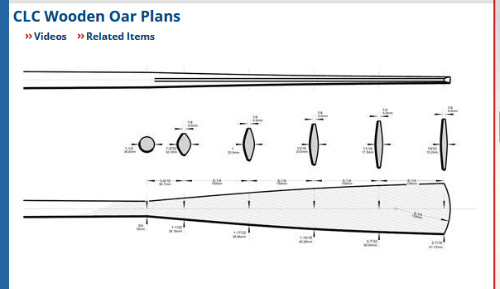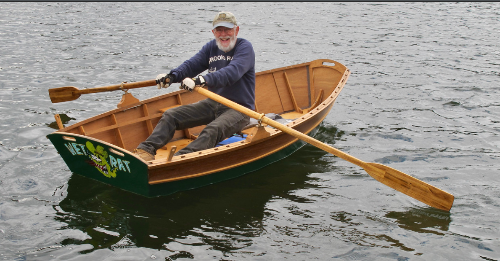Re: Fisherman's Oars, a Documented Build
Posted by Charlie43 on
URL: http://riverswest-forums.266.s1.nabble.com/Fisherman-s-Oars-a-Documented-Build-tp582p583.html
If you're planning to build your own oars, a good place to begin is to look at what others have done, such as the linked video, not much I agree with. But watch it and make up your own mind. https://www.youtube.com/watch?v=snsfkwWIYdE He says that narrow, broom-stick grips -- a style Bolger prefers-- are comfortable to his hands. I don't like 'em. Make up your own mind.
He prefers narrower than average blades, claiming they reduce 'flutter' --a condition I've never experienced-- and that they work better in rougher water. Well, they might. But I'd say that if the water is rough, then on shore is the place to be, not out in a boat, fighting the wind and waves.
He says he made an effort to balance the oars. I'd say he didn't succeed. (More on that latter in the build.)
So, let's address blade shape. CCL uses the same blade pattern for its 6'0" to 7'0" oars, where the following is a table of half breadths:
0.0, 0.00
0.56, 2.24
6.0, 2.16
12.0, 1.88
18.0, 1.47
24.0, 1.00
27.44, 0.69
~50, 0.88
In plain English, the blade tip is curved to have a 5" radius. The max width of the blade is 4.69". The blade narrows rapidly and necks into the loom at 27-7/16" from the tip. (First image.) By comparison, a Caviness blade has roughly the same length and tip radius, but is wider by 3/4" and more "full bodied" throughout its length.

Me rowing with a pair of Caviness (that were thinned and pinned.)

My take is this. CLC's blade is too skinny. Caviness' is too fat. And both are too long. So, here's my compromise.
(1) Use whatever tip radius looks good to your eye.
(2) Make the max length 24" inches --measured from the blade tip to where the blade completely transitions into the loom) or 4" shorter than CLC or Caviness.
(3) Make the max width 4-7/8" to 5-1/8" (depending on how powerful a blade you want and the stock you're cutting the blade from.)
(4) Begin the taper from max width to loom at about 12" from the tip on roughly the following schedule, where a width blade of 5" is assumed and a loom diameter of 1/3/4":
0, 5
4, 5
8, 5
12, 5
16, 4-3/8
20, 3-1/4
24, 1-3/4
28, 1-3/4
(An image of this blade profile will be inserted later.) Meanwhile, here's yet another oar pattern, likely Culler's for an 8' oar. Notice that the blade length is about 29". When that is scaled down for a 6.5'. then the length becomes 23.5", or close to what I typically plan for, though my blades are nearly an inch wider.

Note: The immersed area of the blade --and, of course, whether it's flat or dished-- determines how much water is grabbed on each stroke, and how efficiently it is grabbed, which can translate to 'power', but can also create turbulence. For recreational use, as opposed to racing, a less efficient blade --one that slips a bit-- can be a "kinder" blade to use if one isn't a conditioned, efficient rower. When building oars, go for close to the max bade width your stock will permit and then trim the blade when time on the water proves the blade is too big for you and your purpose for using oars. But if you really want just one number, then I'd say 4-7/8" x 24" is a good compromise for a 6.5' to 7.0' oar.
URL: http://riverswest-forums.266.s1.nabble.com/Fisherman-s-Oars-a-Documented-Build-tp582p583.html
If you're planning to build your own oars, a good place to begin is to look at what others have done, such as the linked video, not much I agree with. But watch it and make up your own mind. https://www.youtube.com/watch?v=snsfkwWIYdE He says that narrow, broom-stick grips -- a style Bolger prefers-- are comfortable to his hands. I don't like 'em. Make up your own mind.
He prefers narrower than average blades, claiming they reduce 'flutter' --a condition I've never experienced-- and that they work better in rougher water. Well, they might. But I'd say that if the water is rough, then on shore is the place to be, not out in a boat, fighting the wind and waves.
He says he made an effort to balance the oars. I'd say he didn't succeed. (More on that latter in the build.)
So, let's address blade shape. CCL uses the same blade pattern for its 6'0" to 7'0" oars, where the following is a table of half breadths:
0.0, 0.00
0.56, 2.24
6.0, 2.16
12.0, 1.88
18.0, 1.47
24.0, 1.00
27.44, 0.69
~50, 0.88
In plain English, the blade tip is curved to have a 5" radius. The max width of the blade is 4.69". The blade narrows rapidly and necks into the loom at 27-7/16" from the tip. (First image.) By comparison, a Caviness blade has roughly the same length and tip radius, but is wider by 3/4" and more "full bodied" throughout its length.

Me rowing with a pair of Caviness (that were thinned and pinned.)

My take is this. CLC's blade is too skinny. Caviness' is too fat. And both are too long. So, here's my compromise.
(1) Use whatever tip radius looks good to your eye.
(2) Make the max length 24" inches --measured from the blade tip to where the blade completely transitions into the loom) or 4" shorter than CLC or Caviness.
(3) Make the max width 4-7/8" to 5-1/8" (depending on how powerful a blade you want and the stock you're cutting the blade from.)
(4) Begin the taper from max width to loom at about 12" from the tip on roughly the following schedule, where a width blade of 5" is assumed and a loom diameter of 1/3/4":
0, 5
4, 5
8, 5
12, 5
16, 4-3/8
20, 3-1/4
24, 1-3/4
28, 1-3/4
(An image of this blade profile will be inserted later.) Meanwhile, here's yet another oar pattern, likely Culler's for an 8' oar. Notice that the blade length is about 29". When that is scaled down for a 6.5'. then the length becomes 23.5", or close to what I typically plan for, though my blades are nearly an inch wider.

Note: The immersed area of the blade --and, of course, whether it's flat or dished-- determines how much water is grabbed on each stroke, and how efficiently it is grabbed, which can translate to 'power', but can also create turbulence. For recreational use, as opposed to racing, a less efficient blade --one that slips a bit-- can be a "kinder" blade to use if one isn't a conditioned, efficient rower. When building oars, go for close to the max bade width your stock will permit and then trim the blade when time on the water proves the blade is too big for you and your purpose for using oars. But if you really want just one number, then I'd say 4-7/8" x 24" is a good compromise for a 6.5' to 7.0' oar.
| Free forum by Nabble | Edit this page |